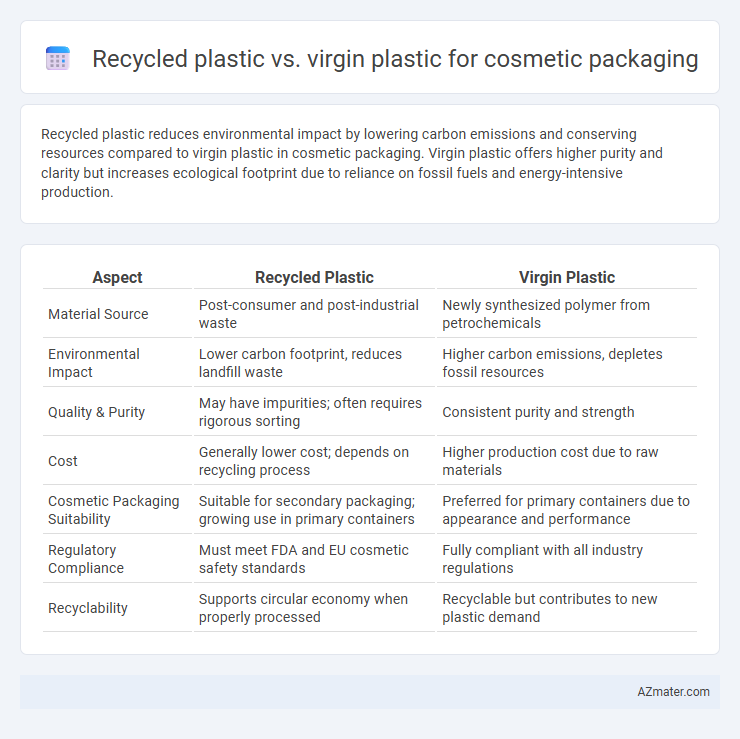Recycled plastic reduces environmental impact by lowering carbon emissions and conserving resources compared to virgin plastic in cosmetic packaging. Virgin plastic offers higher purity and clarity but increases ecological footprint due to reliance on fossil fuels and energy-intensive production.
Table of Comparison
| Aspect | Recycled Plastic | Virgin Plastic |
|---|---|---|
| Material Source | Post-consumer and post-industrial waste | Newly synthesized polymer from petrochemicals |
| Environmental Impact | Lower carbon footprint, reduces landfill waste | Higher carbon emissions, depletes fossil resources |
| Quality & Purity | May have impurities; often requires rigorous sorting | Consistent purity and strength |
| Cost | Generally lower cost; depends on recycling process | Higher production cost due to raw materials |
| Cosmetic Packaging Suitability | Suitable for secondary packaging; growing use in primary containers | Preferred for primary containers due to appearance and performance |
| Regulatory Compliance | Must meet FDA and EU cosmetic safety standards | Fully compliant with all industry regulations |
| Recyclability | Supports circular economy when properly processed | Recyclable but contributes to new plastic demand |
Introduction: The Role of Plastics in Cosmetic Packaging
Plastics dominate cosmetic packaging due to their versatility, durability, and cost-effectiveness, essential for preserving product integrity and enhancing consumer appeal. Virgin plastic offers consistent quality and clarity crucial for premium cosmetics, while recycled plastic supports sustainability by reducing environmental impact and conserving resources. The balance between these materials reflects an industry shift towards eco-friendly innovation without compromising product performance.
Defining Recycled Plastic and Virgin Plastic
Recycled plastic for cosmetic packaging is material processed from previously used plastics, reducing environmental impact by minimizing waste and conserving resources. Virgin plastic is newly manufactured from raw petrochemical sources, offering consistent purity and quality ideal for high-performance packaging requirements. The choice between recycled and virgin plastic hinges on factors like sustainability goals, product safety standards, and consumer preferences in the cosmetic industry.
Environmental Impact Comparison
Recycled plastic in cosmetic packaging significantly reduces carbon emissions by up to 60% compared to virgin plastic production, lowering the overall environmental footprint. Recycled plastics also decrease petroleum dependency and reduce landfill waste, supporting circular economy principles in the beauty industry. However, challenges like contamination and limited recyclate quality persist, making advancements in recycling technology essential for broader sustainability impact.
Manufacturing Processes and Energy Consumption
Recycled plastic in cosmetic packaging typically requires less energy during manufacturing compared to virgin plastic because it bypasses the energy-intensive extraction and polymerization stages. The production of virgin plastic involves higher greenhouse gas emissions due to raw material processing from fossil fuels, whereas recycled plastic reduces environmental impact by utilizing post-consumer waste streams. Despite potential challenges in maintaining material purity, recycled plastics contribute significantly to energy savings and sustainability goals in packaging production.
Cost Analysis: Recycled vs Virgin Plastic
Recycled plastic for cosmetic packaging typically offers cost savings of 10-30% compared to virgin plastic due to lower raw material expenses and reduced energy consumption during production. Virgin plastic costs are influenced by petroleum prices and require more intensive processing, making them consistently higher than recycled alternatives. However, recycled plastic may incur additional expenses for sorting, cleaning, and quality assurance to meet cosmetic industry standards.
Packaging Quality and Performance
Recycled plastic in cosmetic packaging often exhibits slightly lower mechanical strength and clarity compared to virgin plastic, which provides superior durability and a pristine appearance essential for premium cosmetic products. Virgin plastic ensures consistent barrier properties, critical for preserving product integrity and extending shelf life, while recycled materials may vary due to contaminants or polymer degradation. Despite these differences, advancements in recycling technology have improved the performance of recycled plastics, making them increasingly viable for certain cosmetic packaging applications without compromising quality.
Regulatory and Safety Considerations
Recycled plastic used in cosmetic packaging must comply with FDA and EU regulations ensuring no harmful contaminants leach into products, maintaining consumer safety and product integrity. Virgin plastic offers consistent purity and predictable barrier properties but involves higher environmental costs compared to recycled alternatives. Both materials require rigorous testing and certification to meet regulatory standards for cosmetic products, highlighting the importance of traceability and material provenance in packaging selection.
Consumer Perception and Brand Reputation
Recycled plastic in cosmetic packaging enhances brand reputation by resonating with environmentally conscious consumers who prioritize sustainability and ethical practices, driving loyalty and positive consumer perception. Virgin plastic, while often perceived as higher quality and pristine, may negatively impact brand image due to increasing awareness of plastic pollution and environmental harm. Brands adopting recycled plastic demonstrate corporate responsibility, appealing to a growing segment of eco-aware customers and differentiating themselves in a competitive market.
Innovations and Trends in Sustainable Cosmetic Packaging
Recycled plastic in cosmetic packaging significantly reduces environmental impact by lowering carbon emissions and waste compared to virgin plastic, which relies on new fossil fuel resources. Innovations include advanced chemical recycling techniques converting mixed plastic waste into high-purity polymers, ensuring product safety and quality equivalent to virgin materials. Trend indicators highlight growing consumer demand and brand commitments driving adoption of recycled content, biodegradable additives, and lightweight designs to enhance sustainability across the cosmetic packaging industry.
Future Outlook: Toward Circular Beauty Packaging
Recycled plastic in cosmetic packaging significantly reduces environmental impact by lowering carbon emissions and conserving resources compared to virgin plastic. Innovations in polymer technology and increased consumer demand are driving the adoption of recycled materials, promoting durability and aesthetic quality that match virgin plastic standards. The future of circular beauty packaging hinges on scalable recycling infrastructures, regulatory support, and industry-wide collaboration to close the loop on plastic waste and advance sustainability goals.

Infographic: Recycled plastic vs Virgin plastic for Cosmetic packaging
 azmater.com
azmater.com